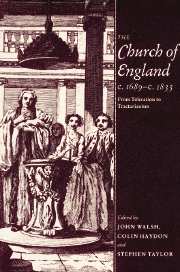Book contents
- Frontmatter
- Contents
- Preface
- List of Abbreviations
- 1 Introduction: The Church and Anglicanism in the ‘long’ eighteenth century
- Part I The pastoral work of the Church
- Part II Crisis and reform
- 5 The Church, the societies and the moral revolution of 1688
- 6 John Locke, Jonas Proast and religious toleration 1688–1692
- 7 The origins and ideals of the SPCK 1699–1716
- 8 Cultural patronage and the Anglican crisis: Bristol c. 1689–1775
- 9 Latitudinarianism at the parting of the ways: a suggestion
- 10 Ecclesiastical policy under Lord North
- 11 The foundation of the Church Missionary Society: the Anglican missionary impulse
- 12 A Hanoverian legacy? Diocesan reform in the Church of England c. 1800–1833
- Part III Identities and perceptions
- Index
8 - Cultural patronage and the Anglican crisis: Bristol c. 1689–1775
Published online by Cambridge University Press: 13 October 2009
- Frontmatter
- Contents
- Preface
- List of Abbreviations
- 1 Introduction: The Church and Anglicanism in the ‘long’ eighteenth century
- Part I The pastoral work of the Church
- Part II Crisis and reform
- 5 The Church, the societies and the moral revolution of 1688
- 6 John Locke, Jonas Proast and religious toleration 1688–1692
- 7 The origins and ideals of the SPCK 1699–1716
- 8 Cultural patronage and the Anglican crisis: Bristol c. 1689–1775
- 9 Latitudinarianism at the parting of the ways: a suggestion
- 10 Ecclesiastical policy under Lord North
- 11 The foundation of the Church Missionary Society: the Anglican missionary impulse
- 12 A Hanoverian legacy? Diocesan reform in the Church of England c. 1800–1833
- Part III Identities and perceptions
- Index
Summary
There has recently been a great revival of interest both in the post-Restoration Church and in the cultural life of English towns during a period dubbed by Peter Borsay ‘the English urban renaissance’. Yet, by and large, the two themes have not been considered in direct relationship. Those who have considered the Church have been preoccupied with its political and ideological significance, above all with the notion of a ‘confessional state’. With the exception of Jeremy Gregory, few have concerned themselves with the cultural life of the Church. Cultural historians have either asserted or assumed that the ‘urban renaissance’ was largely secular, indeed a symptom of the secularization of the elite. Church patronage is ignored since cultural changes are seen as arising from the combined interests of lay patrons, eager to establish or consolidate their status through cultural prestige, and of commercially minded providers of culture, tapping growing surplus incomes. Although it has been recognized that voluntary groups, notably the numerous clubs and societies of the period, played a key part in cultural life, their secular foundations and motivations have been assumed.
Insofar as religion has been discussed, it has been as a negative factor. Religious animosities supposedly delayed the growth of the stability necessary for such a cultural renaissance, whilst one of the renaissance's purposes and effects was to furnish a cultural world safely distinct from the contentious field of denominational religion.
- Type
- Chapter
- Information
- The Church of England c.1689–c.1833From Toleration to Tractarianism, pp. 191 - 208Publisher: Cambridge University PressPrint publication year: 1993



